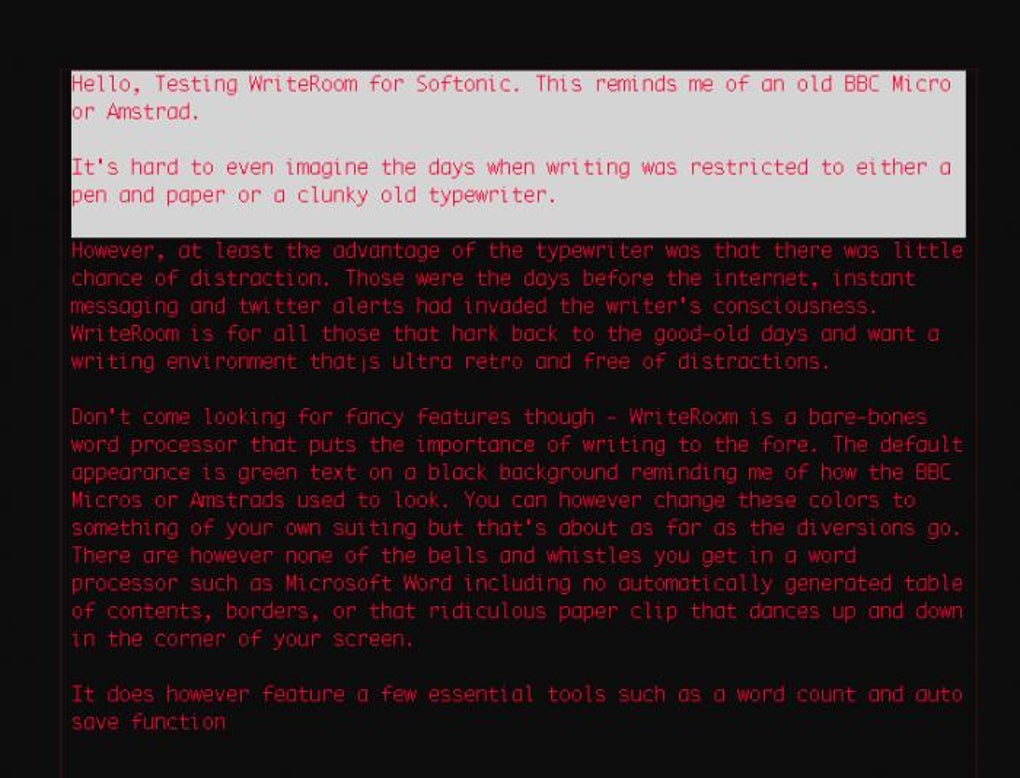

X on my PowerMac G5 and on to the streets, but not without routine crashes and the occasional catastrophic loss of a few finely honed paragraphs. So much for progress.)Īnyway, a few more years, and eventually Unspeak got out of Word v.

Eventually the Psion broke, and nothing as good has replaced it as an ultramobile writing tool.

So something, some unexamined preference, was percolating in my mind.
WRITEROOM MAC MAC
It was for filing articles while travelling, but I often preferred to write on that machine, with its small monochrome LCD, even when my desktop or laptop Mac was available. (In the mean time, I also had one of these. It was a beautiful thing, a real boon to anyone who wrote to predetermined length. The word count was permanently right there in the toolbar, updating as you typed. With Live Word Count, there was no longer any need to hit a key combination every 10 seconds to check the word-count (which was often a way of procrastinating). When pretty much everything you write has a word-limit attached, and you realise after long and tragic experience that exceeding that limit will not cause the editor to expand the space available to you in tribute to your genius but will instead cause the sub-editors unerringly to home in precisely on the bits that must not be cut if the article is still to make any sense and cut them, then you need to know at every stage how much you have written, and how much you have left to go. It was Live Word Count, which (IIRC) appeared in Word v.
WRITEROOM MAC CRACK
And then, like a cunning crack dealer, Microsoft threw me a freebie twist that had me hooked anew. mwd or something, we might have all jumped ship a lot sooner.Īnyway, through inertia, through not even thinking about whether alternatives existed, I continued to stick with Word. doc just is a document, right? And a document has to be a. Part of the reason for Microsoft’s success in this propaganda trick, I think, was its brilliant choice of file-name extension.
WRITEROOM MAC PROFESSIONAL
I was still somehow brainwashed, though, as perhaps many people still are today, into believing that Word was the “serious” word-processor: the professional tool for anyone who did heavy lifting with language. Trigger Happy got out of Word 98 and onto the streets, but not without routine crashes and the occasional catastrophic loss of a few finely honed paragraphs. Yes, I turned off all the crappy lurid toolbars and tried to make the compositional space as simple as possible, but by this time Word was stuffed with all kinds of “features” that let you print a pie-chart on the back of a million envelopes or publish your cookery graphs to your “world wide web home-page”, and it already felt to me that Word was only grudgingly letting me write nothing but, you know, words. Sadly for me, although it wasn’t strictly necessary, after a few years and a colour Performa I “upgraded” to Word 98, and somehow the magic was gone. Many people agree that revision 5.1a, specifically, was the best version of Word that Microsoft has ever shipped, combining utility and minimalist elegance with reliability. For some reason the fact that this is called an Elektrische Schreibmaschine in German makes me feel all nostalgic for the ultrasmooth Kraftwerk future it seems I was living back then without even realising it, tapping out theatre reviews on a six-line green LCD (not even backlit), and then watching the typewriter daisywheel chatter back and forth to print a hard copy, that I would then take to the library and send to the TLS or the Independent, via a facsimile machine, at 10p per page.Īfter a while I was able to buy a black-and-white PowerBook 520 running Word 5:


 0 kommentar(er)
0 kommentar(er)
